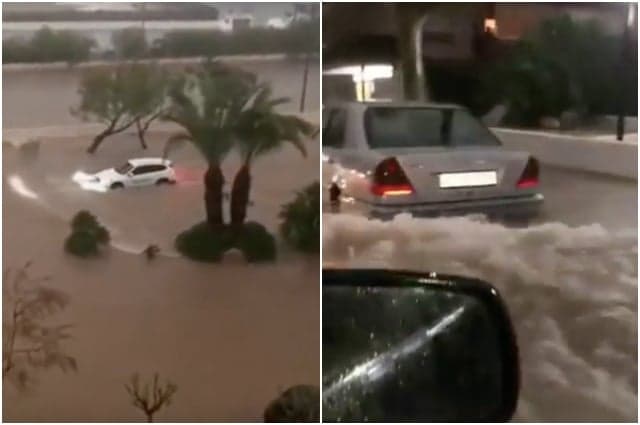In pics: Easter floods tear through Spain’s Costa Blanca

The holiday hotspot of Alicante in eastern Spain has experienced some of the heaviest rainfall in its history, leading to the evacuation of more than 300 people during these Easter holidays. Here are photos and videos that tell the story.
The Easter weather forecast was one of showers for most of Spain but no one expected the rain to come down quite as heavily as it has done for the past three days in and around the city of Alicante.
In the nearby town of Jávea (Xabia) Sunday’s downpour saw 250 litres of rainfall for every square metre, flooding hundreds of homes and leaving cars floating in the streets like corn flakes in a cereal bowl.
Where did you park the car, love? #Javea #xabia pic.twitter.com/SuC75xeFlf
— Ed Page (@EdPage_) April 22, 2019
#Xabia #Javea after unprecedented rain just one example of the scale of the issue in Javea. And the rain hasn’t stopped yet. pic.twitter.com/agPJvxQJ5w
— Ed Page (@EdPage_) April 22, 2019
Fortunately no casualties have been reported but rescue teams did have to evacuate over 100 people from the town.
Scary! #Javea #Xabia pic.twitter.com/5YJglL6H4y
— Ed Page (@EdPage_) April 22, 2019
A further 70 were evacuated in nearby Denia and taken to safety in the car park of the town’s local hospital.
Heavy rainfall and storms have been ravaging the Alicante area since Thursday.
Thunderstorm over flooded #Dénia, Spain ?? 21 April 2019
? @avamet#floods #flooding #flood #storm #stormhour #floodings #severeweather #extremeweather #extremewx #thunderstorm #lightning pic.twitter.com/WJY3mg0v8t
— Windy (@windyforecast) April 22, 2019
As well as the flash floods, wind speeds have reached 100km/h along Spain’s central eastern coastline.
The neighbouring regions of Safor, Ribera Alta and Ribera Baja were also given the red alert for extreme weather conditions by Spain’s meteorology agency AEMET.
Dénia (Alicante) inundada por las tremendas lluvias que están cayendo desde las 6 de la tarde. ??
Impresionante es poco.....???
#GotaFria #Alicante #Denia pic.twitter.com/a5khvx8y8u
— Belén Arrogante (@barrogante) April 21, 2019
In fact, most of the whole autonomous community of Comunidad Valenciana, including its capital Valencia and regions in the interior have experienced at least 100 litres/sqm during the prolonged storm period.
Numerous ports in the region have had to stop operations due to waves of up to three metres in height.
En Denia con temporal de mar pero de momento por debajo de lo previsto #Denia #AEMET #ComunidadValenciana @AEMET_CValencia @apuntoratge @oratgenet @climatologia_ua @eltempsdeDenia @jcfortea pic.twitter.com/XUEfyWjgnl
— Domingo Riera (@domi64) April 20, 2019
The bad weather has spoiled travel plans for the hundreds of thousands of tourists who visit Spain's Costa Blanca during the Easter period. Around 2.2 million people visited Alicante alone in 2017.
According to local government figures from 2018, the province of Alicante is home to more than 67,000 Brits, as well as more than 15,000 Dutch and German residents respectively as well as large numbers of Norwegians and Swedes.
Comments
See Also
The Easter weather forecast was one of showers for most of Spain but no one expected the rain to come down quite as heavily as it has done for the past three days in and around the city of Alicante.
In the nearby town of Jávea (Xabia) Sunday’s downpour saw 250 litres of rainfall for every square metre, flooding hundreds of homes and leaving cars floating in the streets like corn flakes in a cereal bowl.
Where did you park the car, love? #Javea #xabia pic.twitter.com/SuC75xeFlf
— Ed Page (@EdPage_) April 22, 2019
#Xabia #Javea after unprecedented rain just one example of the scale of the issue in Javea. And the rain hasn’t stopped yet. pic.twitter.com/agPJvxQJ5w
— Ed Page (@EdPage_) April 22, 2019
Fortunately no casualties have been reported but rescue teams did have to evacuate over 100 people from the town.
Scary! #Javea #Xabia pic.twitter.com/5YJglL6H4y
— Ed Page (@EdPage_) April 22, 2019
A further 70 were evacuated in nearby Denia and taken to safety in the car park of the town’s local hospital.
Heavy rainfall and storms have been ravaging the Alicante area since Thursday.
Thunderstorm over flooded #Dénia, Spain ?? 21 April 2019
— Windy (@windyforecast) April 22, 2019
? @avamet#floods #flooding #flood #storm #stormhour #floodings #severeweather #extremeweather #extremewx #thunderstorm #lightning pic.twitter.com/WJY3mg0v8t
As well as the flash floods, wind speeds have reached 100km/h along Spain’s central eastern coastline.
The neighbouring regions of Safor, Ribera Alta and Ribera Baja were also given the red alert for extreme weather conditions by Spain’s meteorology agency AEMET.
Dénia (Alicante) inundada por las tremendas lluvias que están cayendo desde las 6 de la tarde. ??
— Belén Arrogante (@barrogante) April 21, 2019
Impresionante es poco.....???
#GotaFria #Alicante #Denia pic.twitter.com/a5khvx8y8u
In fact, most of the whole autonomous community of Comunidad Valenciana, including its capital Valencia and regions in the interior have experienced at least 100 litres/sqm during the prolonged storm period.
Numerous ports in the region have had to stop operations due to waves of up to three metres in height.
En Denia con temporal de mar pero de momento por debajo de lo previsto #Denia #AEMET #ComunidadValenciana @AEMET_CValencia @apuntoratge @oratgenet @climatologia_ua @eltempsdeDenia @jcfortea pic.twitter.com/XUEfyWjgnl
— Domingo Riera (@domi64) April 20, 2019
The bad weather has spoiled travel plans for the hundreds of thousands of tourists who visit Spain's Costa Blanca during the Easter period. Around 2.2 million people visited Alicante alone in 2017.
According to local government figures from 2018, the province of Alicante is home to more than 67,000 Brits, as well as more than 15,000 Dutch and German residents respectively as well as large numbers of Norwegians and Swedes.
Join the conversation in our comments section below. Share your own views and experience and if you have a question or suggestion for our journalists then email us at [email protected].
Please keep comments civil, constructive and on topic – and make sure to read our terms of use before getting involved.
Please log in here to leave a comment.